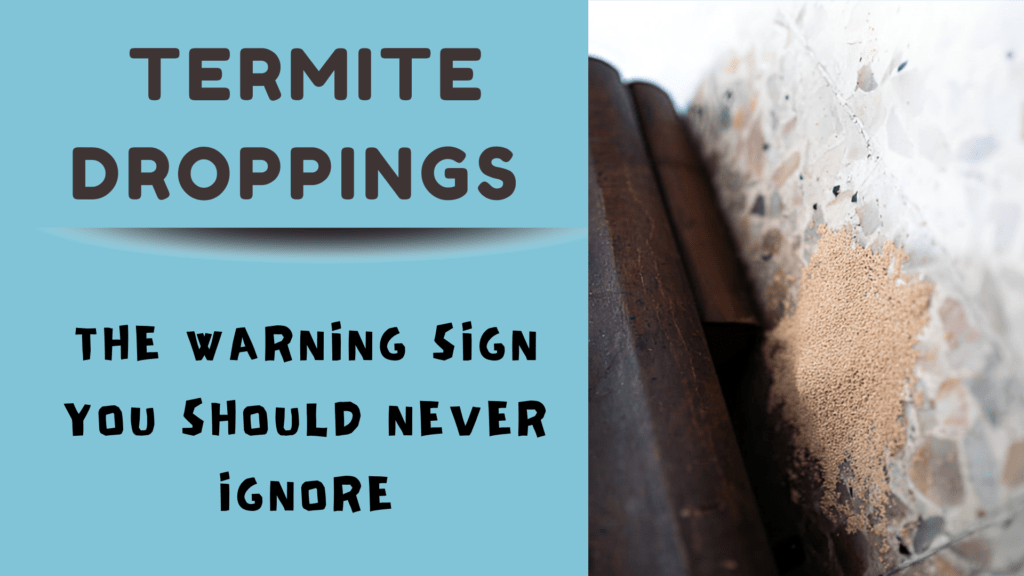
Discovering tiny piles of what looks like sawdust or sand in your home can be alarming. More often than not, these piles are actually termite droppings—also known as frass—a sure sign of a termite infestation.
Understanding what termite droppings look like, where they come from, and what to do if you find them is crucial for protecting your property from costly damage.
What Are Termite Droppings?
Termite droppings, or frass, are the waste products left behind after termites digest wood and other cellulose materials. These droppings are not just a nuisance—they are a warning sign that termites are actively feeding and living inside your home or wooden structures.
What Do Termite Droppings Look Like?
Termite droppings are small, pellet-like, and usually about 1 millimeter in length. They often have six concave sides with rounded ends, resembling miniature capsules or grains of sand.
The color of the droppings can vary depending on the type of wood the termites have consumed:
Light woods: Droppings may be beige or light brown.
Dark woods: Droppings can appear dark brown or even black.
You’ll typically find these pellets in small piles beneath tiny holes in wood, which are called “kick-out holes” or “exit holes”. These holes are used by termites to push frass out of their nests, keeping their living spaces clean.
Where Are Termite Droppings Found?
Knowing where to look for termite droppings is essential for identifying an infestation. Here are some common places where you might find them:
1. Around Wooden Structures
Check for piles of droppings near wooden beams, frames, or furniture. These are common areas for termites to infest.
2. In Your Attic or Basement
Termites often hide in attics or basements where they can feed on wooden materials undisturbed. Look for droppings in these areas, particularly if you notice any other signs of termite activity.
3. Along Walls
If termites have been feeding inside the walls, droppings might collect near cracks or holes in the drywall. These could indicate that termites are tunneling through the interior of your home.
4. Near Wooden Fixtures
Examine wooden doorframes, window sills, and other fixtures for signs of termite damage and droppings. Termites tend to gravitate toward these areas for food.
Types of Termites and Their Droppings
Different types of termites produce different kinds of droppings. Understanding the type of termites in your home can help in identifying the source of the frass:
1. Subterranean Termites
Subterranean termites are the most common type that causes damage to homes. Their droppings are typically fine, powdery, and dark in color. These termites often leave piles of frass near the entrance to their tunnels.
2. Drywood Termites
Drywood termites are another common type of termite, and their droppings are larger than those of subterranean termites. Their frass often appears as a mixture of small pellets and fine powder. Drywood termites infest dry wood and do not require contact with the soil.
3. Formosan Termites
Formosan termites are an invasive species known for causing widespread damage. Their droppings resemble those of subterranean termites but are typically more compact and often appear in larger piles.
Also read:
Powderpost Beetles: How to Spot the Damage Early!
Termite Droppings vs. Other Insect Droppings
It’s easy to confuse termite droppings with sawdust or carpenter ant droppings. Here’s how to tell the difference:
| Feature | Termite Droppings (Frass) | Carpenter Ant Droppings | Sawdust/Shavings |
| Shape | Small, oval, six-sided pellets | Larger, irregular pellets | Fine, powdery, or chunky |
| Color | Varies (beige, brown, black) | Similar, but may have insect parts | Light, uniform color |
| Texture | Granular, compact | Gritty, may contain debris | Fibrous, soft |
| Location | Near exit holes in wood | Near nest entrances in wood | Near woodworking areas |
What Should You Do If You Find Termite Droppings ?
If you discover termite droppings in your home, take the following steps:
Do Not Disturb the Piles: Avoid cleaning up the droppings immediately, as this can help pest control professionals identify the source.
Inspect for Other Signs: Look for additional indicators such as hollow-sounding wood, mud tubes, or discarded wings.
Contact a Professional: Termite infestations can cause significant structural damage. Reach out to a licensed pest control expert for an inspection and treatment plan.
How to Prevent Termites from Entering Your Home
Key Prevention Strategies
- Reduce Moisture Around Your Home
- Fix leaky pipes, faucets, and roofs promptly.
- Ensure proper drainage away from your home’s foundation.
- Avoid overwatering plants near the house.
Eliminate Wood-to-Ground Contact
- Keep firewood, lumber, and wooden debris at least 20 feet away from your home and elevated off the ground.
- Make sure wooden siding and any other wood elements are at least 6 inches above the soil.
Seal Entry Points
- Inspect and seal cracks, gaps, and holes in your foundation, walls, and around utility lines.
- Use caulk or other appropriate materials to block potential entryways.
Use Termite-Resistant Materials
- When building or renovating, opt for termite-resistant wood or metal framing.
- Consider installing physical barriers (such as stainless steel mesh or sand barriers) during construction.
Manage Landscaping and Mulch
- Avoid placing mulch or vegetation directly against your home’s foundation.
- Maintain a clear zone of at least 6 inches (or more, depending on local standards) between soil/mulch and the bottom of your weep holes.
- Use cellulose-free mulch or keep mulch layers thin.
Also read:
Wood-Boring Beetles: Identification, Damage, and Control
Carpenter Ants vs Termites: Which One’s Worse?
Regular Inspections and Monitoring
- Schedule annual professional termite inspections to catch early signs of infestation.
- Use DIY monitoring tools or bait stations to keep an eye on termite activity between inspections.
- Stay Informed and Proactive
- Keep up to date with the latest termite prevention and control methods.
- If you notice signs of termites (e.g., mud tubes, frass, hollow-sounding wood), act quickly and consult a pest control professional.
Additional Tips
Remove Dead Trees and Stumps: Eliminate potential food sources by removing dead wood from your property.
Monitor Used Lumber: Inspect any used or reclaimed wood before bringing it into your home or garden.
Maintain Clearance Around Weep Holes: Ensure weep holes are not blocked by soil, mulch, or vegetation, which can provide easy access for termites.
When to Call a Professional
- For severe or hard-to-access infestations
- If DIY methods have failed
- To maintain preventive treatments and warranties
By following these strategies, you can significantly reduce the risk of termites entering your home and protect your property from costly damage.
Final Thoughts
Termite droppings, or frass, are an important sign of an active termite infestation. Identifying and understanding these droppings early can help you prevent extensive damage to your home. If you find termite droppings, it’s important to act quickly and contact a pest control professional to address the issue. By taking preventive measures, you can reduce the risk of a termite infestation in the future.
Frequently Asked Questions (FAQs)
Q: What do termite droppings look like?
Termite droppings are small, cylindrical pellets that are typically dark brown or black. They have a fine, powdery texture and are often found near wooden structures.
Q: How can I tell if I have a termite infestation?
If you find piles of tiny pellets near wooden furniture or walls, or if you notice damage to your wood, it could indicate a termite infestation. Look for other signs like mud tubes or hollow-sounding wood.
Q: Are termite droppings harmful?
While termite droppings are not harmful to humans, they indicate the presence of termites, which can cause significant damage to your home if left untreated.
Q: How do I clean termite droppings?
You can clean termite droppings by vacuuming them up and wiping down the area with soap and water. However, cleaning alone won’t eliminate the infestation.
Q: Can termite droppings be mistaken for other pests?
Yes, termite droppings can be confused with the droppings of other pests like carpenter ants or beetles. However, termite frass is unique in its texture and shape.

